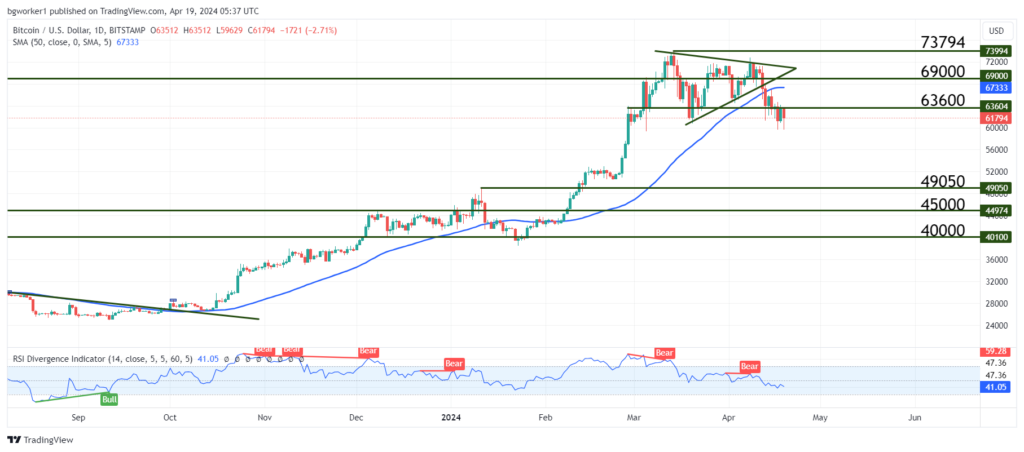The Halving Is Upon Us: Less Than a Day to Go
Bitcoin Struggles at Resistance. How Will the Halving Affect it?
This week marks a significant event for Bitcoin—the upcoming halving, which will slash the mining reward from 6.25 BTC to 3.125 BTC per block. This adjustment is expected to shake up the mining world, with some predicting that less profitable miners may leave the network. If this happens, it may lead to a notable decline in Bitcoin’s overall computing power and a reorganization towards more efficient, often publicly-listed mining operations.
There’s also speculation that post-halving, some mining firms might move to regions with cheaper energy costs, like Latin America or Africa. This could help repurpose older, less efficient rigs, extracting whatever remaining value they can still produce.
There’s a cautious outlook from market analysts regarding Bitcoin’s price trajectory post-halving. Contrary to the historical trend where halvings triggered price increases, experts like those from JPMorgan suggest that any potential price surge might already be reflected in the current market prices. They anticipate that prices might actually drop post-halving due to a combination of factors, including ‘overbought conditions’ and a price that is still hovering above the projected production cost. But then again, JPMorgan and Bitcoin haven’t always been best friends.
So, what is the Bitcoin halving?
This event dates back to Bitcoin’s inception following the 2008 financial crisis. Created by the pseudonymous Satoshi Nakamoto in 2009, Bitcoin was pictured as a currency free from government or central bank control.
Satoshi capped Bitcoin’s total supply at 21 million to curb inflation and enhance its value over time. Note the totally different approach compared to central banks like the Fed, which can alter money supply as needed. ‘Need more money? Just print it.’
On the other hand, Bitcoin releases new coins at a fixed, decreasing rate; nobody can decide to ‘just print’ a Bitcoin. Every four years, the reward for mining new blocks is halved, hence the term “halving.” This scarcity mechanism theoretically increases each Bitcoin’s value as they become harder to generate.
Historically, halvings have led to price increases. Post-2012’s halving, Bitcoin’s price jumped from $12.35 to $127 in five months. The 2016 halving saw the price rise to $1,280 within eight months. More recently, the price surged from $8,700 to $60,000 between the 2020 halving and early 2021. Each event has bolstered the belief that halvings significantly impact Bitcoin’s market value by making the coins rarer and, potentially, more desirable.
Chart Analysis – BTC/USD
After dropping as low as $59,700, and exiting the triangle pattern, Bitcoin is currently trading around $62,000 and has already attempted a break above $63,600 which was support and is currently resistance.
Thus far this barrier is holding but if it is surpassed, we should look for a break above the 50-day Moving Average, which could mean that the Digital King is preparing to reignite the uptrend and possibly challenge for a new All-Time High.
The next day(s) will be crucial because although the halvings have generated price increases in the past, there’s a first time for everything and we should not disregard a price decrease after the halving occurs.
